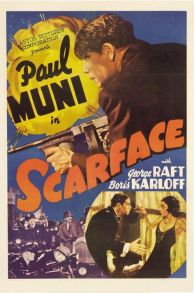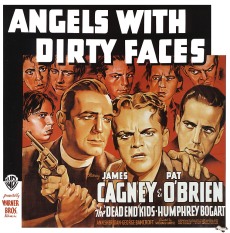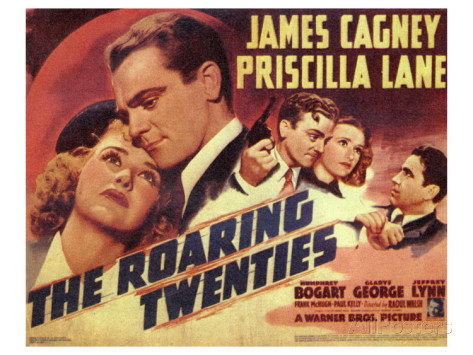by Paul Batters

“Morning, gentlemen. Nice day for a murder.” Rocky Sullivan ‘Angels With Dirty Faces’ (1938)
The story of the gangster has been a part of the film experience since the earliest days of cinema. Whether we like to admit it or not, audiences are both repelled yet fascinated by the darkest elements of our society and those who live in its’ shadows without keeping regular hours.
Film has shaped an anti-hero out of the gangster. Shaped out of some romanticised notion of the gangster as a rebel against the authorities and refusing to accept mediocrity, cinema has (inadvertently or not) played its’ role in shaping this persona. Our mouths open wide in shock and horror, appalled by the brutal and sometimes-indiscriminate violence these men in silk suits perpetrate. Yet we quietly admire their propensity to deal out swift justice to those that cross them. We can be disgusted by their ease in making money from criminal activities that plague our communities such as drugs and prostitution. Yet we yearn for financial freedom ourselves, as well as a taste of the glamorous life they seem to enjoy.
Despite the gangster film making its’ appearance in film industries outside Hollywood, authentic to their own cultural and social experiences, the gangster film as we know it was shaped in the U.S. Martin Scorsese has stated that the gangster film, like the Western, is an American genre borne out of an American context. Yet despite this, the gangster figure is very much an exotic figure, within its’ own space in the cultural milieu of Americana. And whilst a construct of the cinema and far removed from the reality, the cinema gangster has proven a glamorous and exciting figure to audiences.
Whilst there is conjecture over whether the gangster film stands alone as a genre or is a sub-genre of crime, it should be noted that the film gangster across such diverse areas as comedy, the musical and even in horror. Yet in whatever way the persona is brought across in specific genres, the film gangster is definitive in how he is identified. It is a persona clearly shaped during the formative years of the gangster film in the early 1930s.
As early as 1912, gangsters were portrayed in D.W Griffith’s Musketeers Of Pig Alley (1912) – a short that depicted the tough street gangs of New York City, specifically the slums of Manhattan’s Lower East Side, preying on the innocent. To bring realism to the scenes, actual gang members were hired as extras, creating an atmosphere and introducing characteristics that would later become part of the quintessential screen gangster – the cocky swagger, charm and code of honour.
Honoured as the first ‘gangster film’, Musketeers Of Pig Alley’ depicts the gangsters as how they were perceived at the time – street hoodlums and thugs, armed with knuckle-dusters, knives and bats. It would still be some years before Prohibition would backfire and literally create the silk-suited, gun-toting mobster, awash with money from bootleg money and the clout to corrupt politicians and the law. However, it holds its’ place in film history.
Gangsters would still be depicted on film during the silent era and into the early years of the talkies. But the portrayals seemed unconvincing and were often secondary to the main storyline.
All that would change with the release of three films in the Pre-Code era– two by Warner Brothers within the space of a year and another by the eccentric Howard Hughes. All three would change cinema and the reverberations from those three films are still with us today.
Those films were Little Caesar and The Public Enemy (both 1931) and Scarface (1932).



The public concept of the gangster was now well-entrenched, not by Hollywood but by the headlines in newspapers and even what people where witnessing in their own neighbourhoods and cities. The very law whose aim was to enforce morality upon American society would in essence to do the very opposite – Prohibition would end up encouraging people to drink, there would more drinking establishments in operation than before Prohibition and it turned ordinary people into law-breakers. Everyone knew where to get an illegal drink. The 1920s was a time flush with money, especially for the new rising gangsters who not only intended to make more money but also intended to keep control of how they made it – and show they were here to stay. The public admired some of these ‘colourful characters’, providing a service against what many believed was an unjust law.
But it was the Depression that would truly cement the persona in the public’s mind as a lone wolf railing against his circumstances and making it big, only to lose it all. There might have been the underlying morality tale of the wrongs of crime but the public suffering the effects of the Depression connected – they felt the system had failed and they were powerless to act. Even the politicians had no answer. Yet the gangsters seemed to have one – and audiences admired this.
The three aforementioned films would appeal to audiences for these reasons and more. Producers were switched on enough to know that sex and violence in films meant greater profits, and with the Depression having a disastrous impact on the film industry, the studios upped the ante.
Both Little Caesar and The Public Enemy tell the story of the meteoric rise and fall of tough guys Enrico ‘Little Caesar’ Bandello (Edward G Robinson) and Tom Powers (James Cagney), marked by ruthlessness and violence. The glamor of crime was obviously appealing to an audiences but the warning of what would befall anyone entering the world of crime was also clear. The allegory was obvious – the system could not be defeated and one needed to accept the world as it was, or face the consequences that Enrico Bandello and Tom Powers would.


Both characters had great force of personality and were individuals against the world – those who got in the way would be hurt. But there was a price to pay. Whatever those consequences may be, these anti-heroes were magnetic and exploded off the screen in a way no character had before.
Whilst Bandello and Powers were fictional characters, there was no hiding who Tony Camonte (Paul Muni) of Scarface was. The Al Capone reference was painfully obvious. Like Bandello in Little Caesar, both were also Italian, making obvious reference to ethnicity and issues of immigration. Of the three films, Scarface is the more violent and moments in the film point to actual events that audiences would have identified.

What also unites the films is that despite the violent endings of all three films and the underlying morality tale, Bandello, Powers and Camonte were not seen as the ‘bad guy’ by audiences and it was the authorities that audiences wanted to see fail in their pursuit of these criminal upstarts. Audiences transferred their frustrations with the so-called American Dream, inept government and corrupt officials onto the authorities they saw on the screen.
Robinson, Cagney and Muni were already established actors but their portrayals would launch them into the stratosphere. All three would not necessarily be typecast and their versatility would see them in a range of roles throughout their career. But both Robinson and Cagney would play gangsters again, bringing different approaches with storylines directed by the Hays Production Code.
It was no accident that Edward G. Robinson, James Cagney, Humphrey Bogart and later George Raft would be working at Warner Brothers – the studio that would establish and dominate the gangster film cycle of the 1930s, in much the same way that Universal established the classic horror cycle. All the major studios would make gangster films but Warner Brothers defined it. There was a stylistic imprint that the studio had, particularly in the mid 1930s to early 1940s, which stood out with a crisp, cinematic composition, fast dialogue and honed characterisation.
The new code would change the gangster genre almost as soon as it was born. Whilst sex and violence was an issue, the real concerns were that the gangster was the focus for audiences and not the authorities fighting crime. As a result, the focus would switch – in a number of ways. Gangsters could be shown in a totally negative light as plot devices for the main story as in Manhattan Melodrama (1934), The Petrified Forest (1935), Kid Galahad (1937) and The Amazing Dr Clitterhouse (1938). There would also be a shift to the authorities pursuing the criminals as in G-Men (1935), Bullets Or Ballots (1936) and Marked Woman (1937). Finally, the criminal or gangster could be depicted finally seeking salvation as in San Quentin (1937), Angels Wear Dirty Faces (1938) and Invisible Stripes (1939). Incidentally, Edward G Robinson, James Cagney, George Raft and Humphrey Bogart would appear in these films, playing across these shifts, in both gangster and authority roles.

The question arose, as it does today – what creates the gangster? Film would answer that question by raising socio-economic concerns and that environment ultimately created the gangster. This was already evidenced to some degree in the original three films; they had emerged from the ‘lower classes’. The fall out of the Industrial Revolution had seen the emergence of the working class; the masses toiling and sweating in factories and living in impoverished conditions. Class-consciousness saw a working class with the cards stacked against them and unable to break the cycle. They saw the few in the higher echelons of society enjoying the fruits of success, from which they were cut off. To paraphrase the line from dozens of gangster films, those few rebels against society made a decision – to take what they would not be given. No wonder that the audiences consisting mainly of this working class connected with the gangster. Films like Dead End (1937) and Angels With Dirty Faces (1938) would make commentary on how the streets created criminals and the plight of escaping a life of crime.


In contrast, both films also raised the aspect of individual choice. In Dead End, Humphrey Bogart’s Baby Face Martin is very much a product of environment, growing tough in the slums and as he points out ‘ I got mine, I took it’. But Joel McCrea’s Dave Connell takes a different route. Despite growing up with Martin in the same slums, he becomes an architect. But here the harsh cruel reality hits home, which Martin himself laughs at, when the most work Dave can get is painting a store front window in the neighbourhood. Depression audiences would have resonated with this – the American Dream gone sour. Perhaps crime did pay after all – even if it was in the short term. In Angels With Dirty Faces, the story commences showing two pals, also tough and up to no good, who through a quirk of fate as much as choice take two different paths – Pat O’Brien becomes a priest, James Cagney a gangster. The earlier Manhattan Melodrama from MGM saw the same theme with Gable running an illegal casino and his boyhood pal William Powell becoming a D.A. How much is individual choice and much is circumstance?
The context of the 1930s also saw the concept of the ‘forgotten man’ – the World War One returned hero to whom promises were quickly neglected once the war was over. The Depression would hit them hardest of all and again, conditions seemed to determine the path some of these men has to take, as illustrated in The Roaring Twenties (1939) – arguably the last great film of the original gangster cycle; and fittingly Cagney in the star role, finishing what he helped to start.

The arrival of World War Two and the end of the Depression did not see the end of the gangster film but certainly saw the end of the original gangster cycle that Warner Brothers has created and shaped. Even as it was ending, a new genre was emerging, hallmarked by Bogart in The Maltese Falcon (1941). Film noir would offer another slant on the gangster, along with a new outlook on crime and the dark streets of the city. But society was also changing and the old style gangster in the world of crime was also defunct. The term organised crime took on a deeper meaning, where the ‘gangs’ had now become corporate, operating with a board of directors, using business language and leaving the ‘tough stuff’ to lackeys way down the ladder. I Walk Alone (1948) made this very clear, illustrating that things had changed in response to a darker, more sophisticated world.
Time and time again, the gangster has been re-invented to suit new contexts. New interpretations also prevented the gangster from becoming a one-dimensional caricature, unless being parodied or even dusted with a little sentimentality, where Wilder did both in Some Like It Hot (1960).
Yet there is something has remained unchanged since the 1930s gangster film. Despite the end of the Hays Code decades ago and the shift in values and attitudes in audiences since, the fate of the film gangster is usually a bad one. If the authorities don’t get their hands on them, the streets eventually will and usually do. It is an extremely rare film that sees the gangster walk off into the sunset to live out their years in peace. Theirs is a violent world and to that violence they succumb – however long it takes.
Paul Batters teaches secondary school History in the Illawarra region and also lectures at the University Of Wollongong. In a previous life, he was involved in community radio and independent publications. Looking to a career in writing, Paul also has a passion for film history.
Great post. Thank you for sharing at The Classic Movie Marathon Link Party.
LikeLiked by 1 person
This post is being featured in the next Classic Movie Marathon Link Party which begins Monday night.
LikeLiked by 1 person
Thank you so much!
LikeLike
Thank you so much for your positive comments. 🙂
LikeLike
Fabulous analysis of the gangster film and whey they continue to be fascinating films. You’ve got me wanting to spend the rest of the day watching Warner Bros gangster films!
LikeLiked by 1 person
Thank you so much! I’m glad you enjoyed it and there are certainly worst things to do than spend a day watching Warner Bros gangster films! I always find them both fascinating and enjoyable, and of course you have such wonderful casts in them. Thanks so much for taking time to read and appreciate your kind comments. Best regards!
LikeLiked by 1 person
Excellent analysis and wonderfully written!
LikeLiked by 1 person
Thank so much Carol!
LikeLiked by 1 person
Terrific post! Reading this has made me want to watch some James Cagney films.
LikeLiked by 1 person
You can’t go wrong with Cagney!
LikeLike
Great post, Paul. My next post will be about Angel with Dirty Faces, so of course I had to read your essay. 🙂
LikeLiked by 1 person
Thanks Margot! Check my other two on The Public Enemy and The Roaring Twenties. I’m looking forward to reading your next post! Will keep an eye out for it. 🙂
LikeLike
The Gangster era of films is my all time favorite and, of course, James Cagney is my favorite actor. Absolutely wonderful post!
LikeLiked by 1 person
The classic gangster era is a favourite of mine as well. Glad you enjoyed the read!
LikeLike